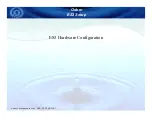
- 9 -
Board
Fuse
F 1: fuse to protect supplying input, from
F 1A L250 V.
Supplying must become from a
very low security tension circuit
featuring a limited power source
protected by fuse
The radio system
With regard to signal transmission in security field, special care has been used in order to improve
efficiency and reliability of the system.
In special way:
- transmission on new European frequency 868 Mhz
- frequency modulation (FM)
- use of an “owner” code
- redundant transmission of messages
Any transmitter is supplied by a 3V battery (use of lithium battery is recommended) usually allowing 1
to 2 years life and is programmed to give indication of low battery to the receiver (interface) with prior
notice before total discharge. Furthermore, in order to save energy, movement detectors can work in
“save mode” which allows alarm transmission only after 3 minutes of total quiet in the room. This means
that detectors installed in rooms with frequent passage remain blocked with no need for unesful
transmissions.
The transmission of radio waves in rooms with many obstacles such as walls, furniture, metal objects
etc. is subject to a phenomen which produces high-intensity zones and “shadow” zones where intensity
of the signal is very low or absent. This happens because signals irradiated by the same transmitter
and reflected in different way by the environment can cancel each other.
It is very important to follow these indications in order to improve efficiency of the system:
•
interface must be installed as near as possible to the protected area.
•
if the building is multi-floor, avoid cellar, garage and peripherical areas giving preference to
medium or upper floors.
•
do not install receiver into wardrobes, especially if in metal and maintain an adequate distance
from metal or concrete structures; the same indications are valid for transmitters.
•
Do not intall receiver near the floor, always maintain 1,50 meters height or more from the ground.
As general rule consider that the higher is installed the receiver, the wider will be its range.
•
Before fixing transmitters into the position chosen, check level of signal received in the receiver
following procedure as described in paragraph “Acquisition of detectors”.
•
In case the signal level of a transmitter is not enough, draw the transmitter near to the receiver.
•
Do not fix other devices straight near the receiver.
E
N
G
Summary of Contents for INTW4S
Page 22: ... 22 ...
Page 23: ... 23 ...










































